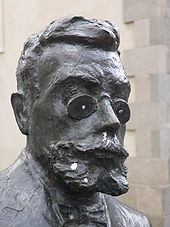
Catalan, known in the Valencian Community and Carche as Valencian, is a Western Romance language. It is the official language of Andorra, and an official language of two autonomous communities in eastern Spain: Catalonia and the Balearic Islands. It is also an official language in Valencia, where it is called Valencian. It has semi-official status in the Italian comune of Alghero, and it is spoken in the Pyrénées-Orientales department of France and in two further areas in eastern Spain: the eastern strip of Aragon and the Carche area in the Region of Murcia. The Catalan-speaking territories are often called the Països Catalans or "Catalan Countries".

Occitan, also known as lenga d'òc by its native speakers, sometimes also referred to as Provençal, is a Romance language spoken in Southern France, Monaco, Italy's Occitan Valleys, as well as Spain's Val d'Aran in Catalonia; collectively, these regions are sometimes referred to as Occitania. It is also spoken in Calabria in a linguistic enclave of Cosenza area. Some include Catalan in Occitan, as the distance between this language and some Occitan dialects is similar to the distance between different Occitan dialects. Catalan was considered a dialect of Occitan until the end of the 19th century and still today remains its closest relative.
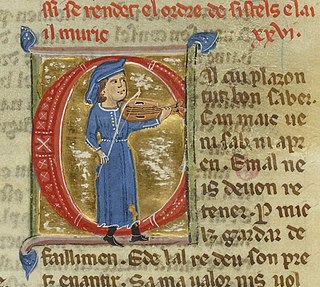
A troubadour was a composer and performer of Old Occitan lyric poetry during the High Middle Ages (1100–1350). Since the word troubadour is etymologically masculine, a female troubadour is usually called a trobairitz.

The Catalan Countries are those territories where the Catalan language is spoken. They include the Spanish regions of Catalonia, the Balearic Islands, Valencian Community, and parts of Aragon and Murcia (Carche), as well as the Principality of Andorra, the department of Pyrénées-Orientales in France, and the city of Alghero in Sardinia (Italy). It is often used as a sociololinguistic term to describe the cultural-linguistic area where Catalan is spoken. In the context of Catalan nationalism, the term is sometimes used in a more restricted way to refer to just Catalonia, Valencia and the Balearic Islands. The Catalan Countries do not correspond to any present or past political or administrative unit, though most of the area belonged to the Crown of Aragon in the Middle Ages. Parts of Valencia (Spanish) and Catalonia (Occitan) are not Catalan-speaking.
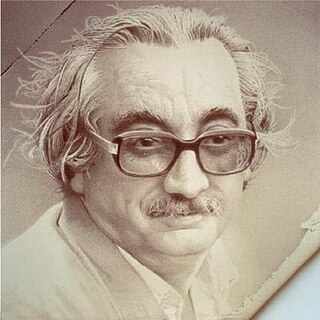
Joan Fuster i Ortells was an influential Spanish writer. He is considered a major writer in the Valencian language, and his work contributed to reinvigorate left-wing, pro-Catalan nationalism in Valencia during the Spanish transition to democracy. In his influential political essay Nosaltres, els valencians (1962) he coined the term Països Catalans to refer to the Catalan-speaking territories.

Josep Carner i Puigoriol, was a Spanish poet, journalist, playwright and translator. He was also known as the Prince of Catalan Poets. He was nominated for the Nobel Prize in Literature seven times.
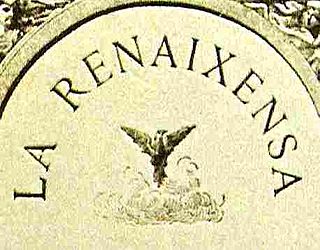
The Renaixença, or Catalan Renaissance, was a romantic revivalist movement in Catalan language and culture through the mid 19th century, akin to the Galician Rexurdimento or the Occitan Félibrige movements. The movement began in the 1830s and lasted until the 1880s, when it branched out into other cultural movements. Even though it primarily followed a romantic impulse, it incorporated stylistic and philosophical elements of other 19th century movements such as Naturalism or Symbolism. The name does not indicate a particular style, but rather the cultural circumstances in which it bloomed.

Anti-Catalanism is the collective name given to various historical trends in France, Italy, and Spain that have been hostile to Catalan culture and traditions.
The early modern period in Catalan literature and historiography, while extremely productive for Castilian writers of the Siglo de Oro, has been termed La Decadència, an era of decadence in Catalan literature and history, generally thought to be caused by a general falling into disuse of the vernacular language in cultural contexts and lack of patronage among the nobility, even in lands of the Crown of Aragon. This decadence is thought to accompany the general Castilianization of Spain and overall neglect of the Crown of Aragon's institutions after the dynastic union of the crowns of Castile and Aragon that resulted from the marriage of Ferdinand II of Aragon and Isabella I of Castile, a union finalized in 1474.
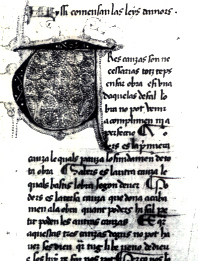
The Consistori del Gay Saber was a poetic academy founded at Toulouse in 1323 to revive and perpetuate the lyric poetry of the troubadours.
The Consistoride Barcelona was a literary academy founded in Barcelona by John the Hunter, King of Aragon and Count of Barcelona, in 1393 in imitation of the Consistori del Gay Saber founded in Toulouse in 1323. The poetry produced by and for the Consistori was heavily influenced by the troubadours. The Consistori's chief purpose was to promote "correct" styles and themes and discourage vices (vicis) by awarding prizes in competition to poets who adhered to the "rules" of poetic composition. The names of few poets laureate have come down to us and despite some excellent descriptions of the Consistori's activities, associated persons and poems are obscure.
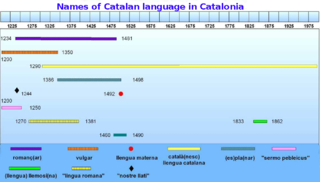
The first names, or glossonyms, of the Catalan/Valencian language formed in a dialectal relation with Latin, in which Catalan existed as a variety. These names already expressed the relationship between the two languages. New names that related Catalan to Rome came about to dignify the Catalan language in the thirteenth century, though Latinists called it vulgar and the people planus, or pla.
Floral Games were any of a series of historically related poetry contests with floral prizes. In Occitan, their original language, and Catalan they are known as Jocs florals. In French they became the Jeux floraux, and in Basque Lore jokoak. The original contests may have been inspired by the Roman Floralia held in honour of Flora.

Joan Margarit i Consarnau was a Catalan poet, architect and professor. Most of his work is written in the Catalan language. He won the 2019 Miguel de Cervantes Prize.
The first complete Catalan Bible translation was produced by the Catholic Church, between 1287 and 1290. It was entrusted to Jaume de Montjuich by Alfonso II of Aragon. Remains of this version can be found in Paris.

The Catalan language originated from Vulgar Latin in the Pyrenees Mountains between France and Spain. It diverged from the other Romance languages in the 9th century. At that time, Catalan spread quickly throughout the Iberian peninsula when the Catalan counts conquered Muslim territory. By the 11th century, the Catalan language was present in several feudal documents. Catalan was present throughout the Mediterranean by the 15th century. At that time, the city of Valencia was thriving.

David Castillo i Buïls is a Spanish poet, writer, and literary critic. He started out as a poet with counterculture and underground publications in the 1970s, although his first published work, a declaration of principles, was the biography of Bob Dylan in 1992. Three years earlier, he had been the anthologist of Ser del segle, which brought together leading voices of the generation of the 1980s. They were followed by a series of poems among them "Game over", which won the Carles Riba Poetry Award. Then he began a career as a writer with novels like El cel de l'infern and No miris enrere, that were well accepted both by critics and the general public. El cel de l'infern was awarded the Crexells Prize for the best Catalan novel of the year in 1999. No miris enrere won the Premi Sant Jordi de novel·la of 2001. Castillo has received Atlàntida awards for journalism three times, and he has also been awarded the Italian "Tratti Poetry Prize for the best foreign poet" for his anthology of poetry translated into Italian. He has been organizing various poetic cycles. He is a founder of Poetry Week in Barcelona, and has been a director of it since 1997.
Valencian regionalism is a cultural and political movement that advocates the revival of the identity of the region now within the Valencian Community in eastern Spain. Politically, the regionalists support the administrative decentralisation of the Spanish state and, for some, the recognition of Valencian foral law and increased autonomy for the Valencian Community. The movement emerged during the early years of the Bourbon restoration in the last third of the 19th century. It took political shape during the early 20th century, and persisted in a controlled and attenuated form through the Francoist State. After the restoration of democracy, the regionalist tendency was challenged by a Valencian nationalism with some left-wing and pan-Catalanist associations. Regionalism took on a right-wing and anti-Catalanist outlook which became known as Blaverism, and was represented politically by the Valencian Union until the absorption of that party into the People's Party in 2011.
Josep Palomero i Almela is a Valencian linguist and vice-president of the Valencian Language Academy.

Joan Triadu i Font was a Catalan literary critic, academic and writer. A cultural and resistant anti-Francoist activist, he was involved in many important Catalan cultural projects in the twentieth century, including the magazines Serra d'Or and Ariel, the newspaper Avui and the association Òmnium Cultural. He was a pioneer in the teaching of Catalan language courses after the Spanish Civil War. As an educationalist, he was the general director of the Cultural Institute of the Centre of Catholic Influence, an institution that created the Thau Barcelona School in 1963 and the Thau Sant Cugat School in 1996. Joan Triadú Year, which marked the centenary of his birth, was celebrated in 2021.

